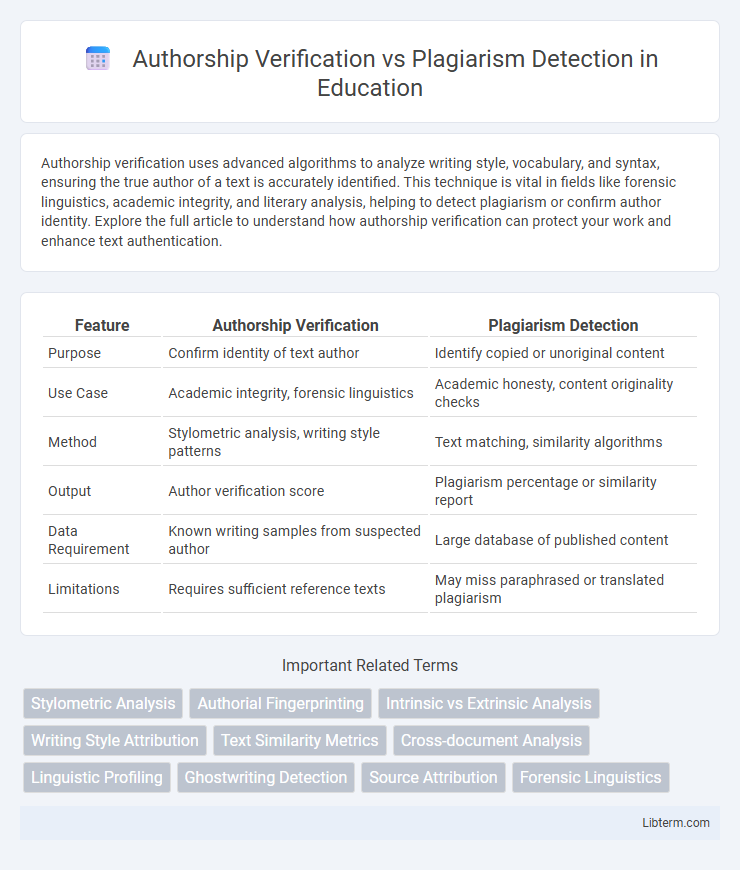Authorship verification uses advanced algorithms to analyze writing style, vocabulary, and syntax, ensuring the true author of a text is accurately identified. This technique is vital in fields like forensic linguistics, academic integrity, and literary analysis, helping to detect plagiarism or confirm author identity. Explore the full article to understand how authorship verification can protect your work and enhance text authentication.
Table of Comparison
| Feature | Authorship Verification | Plagiarism Detection |
|---|---|---|
| Purpose | Confirm identity of text author | Identify copied or unoriginal content |
| Use Case | Academic integrity, forensic linguistics | Academic honesty, content originality checks |
| Method | Stylometric analysis, writing style patterns | Text matching, similarity algorithms |
| Output | Author verification score | Plagiarism percentage or similarity report |
| Data Requirement | Known writing samples from suspected author | Large database of published content |
| Limitations | Requires sufficient reference texts | May miss paraphrased or translated plagiarism |
Understanding Authorship Verification
Authorship verification involves determining whether a specific individual wrote a given text by analyzing linguistic patterns, writing style, and textual features unique to the author. This process relies heavily on machine learning algorithms and stylometric techniques to capture distinctive authorial traits, enabling the differentiation between genuine and disputed texts. Unlike plagiarism detection, which identifies copied content across documents, authorship verification emphasizes the authenticity and originality of the text's creator based on writing style analysis.
Defining Plagiarism Detection
Plagiarism detection involves identifying instances where content has been copied or closely imitated without proper attribution, aiming to uphold originality and intellectual property rights. This process uses algorithmic comparison techniques to scan text against extensive databases and online sources to find similarities and potential matches. Unlike authorship verification, which focuses on confirming the identity of the writer, plagiarism detection centers on uncovering unauthorized reproduction of existing material.
Core Differences Between Authorship Verification and Plagiarism Detection
Authorship verification focuses on determining the true author of a text by analyzing unique writing style features such as syntax, vocabulary, and stylistic patterns, while plagiarism detection identifies copied or closely similar content across different sources to flag unauthorized reproduction. Authorship verification uses stylometric analysis and machine learning models to compare writing samples for attribution, whereas plagiarism detection relies on text matching algorithms and databases to find exact or near-exact text overlaps. The core difference lies in authorship verification attributing texts to individuals, and plagiarism detection identifying content duplication regardless of original authorship.
Methods Used in Authorship Verification
Authorship verification primarily employs stylometric analysis, machine learning algorithms, and neural networks to identify unique writing patterns and linguistic features that distinguish an author's style. Techniques such as n-gram frequency analysis, syntactic parsing, and feature extraction of lexical, syntactic, and semantic variables enable precise attribution of text. Unlike plagiarism detection which relies heavily on text matching and similarity metrics, authorship verification focuses on behavioral writing traits to confirm or refute authorship identity.
Techniques for Plagiarism Detection
Plagiarism detection relies heavily on techniques such as string matching, fingerprinting, and stylometric analysis to identify copied or closely paraphrased text across documents. Advanced methods incorporate machine learning algorithms that analyze contextual, syntactic, and semantic similarities to enhance detection accuracy. Tools like Turnitin and Copyscape utilize large-scale database comparisons combined with heuristic algorithms to efficiently uncover text reuse and potential academic misconduct.
Applications of Authorship Verification
Authorship verification is primarily applied in forensic linguistics, literary analysis, and cybersecurity to confirm or deny the authorship of disputed documents. It aids academic institutions in detecting contract cheating by analyzing writing style features unique to each author. Corporations and legal entities use authorship verification to authenticate internal communications and digital content, ensuring intellectual property rights and preventing fraud.
Real-World Uses of Plagiarism Detection
Plagiarism detection plays a crucial role in academic institutions to ensure the originality of student submissions and maintain academic integrity. In the publishing industry, plagiarism detection tools help identify unauthorized copying to protect intellectual property and uphold ethical standards. Corporate environments use plagiarism detection to verify the uniqueness of marketing content and technical documents, preventing legal issues and preserving brand reputation.
Challenges Faced in Authorship Verification
Authorship verification encounters significant challenges such as limited training data for individual authors, stylistic variability across different genres, and the influence of intentional disguise or collaboration on writing style. Unlike plagiarism detection, which relies on exact or near-exact text matching, authorship verification requires advanced machine learning models to analyze subtle linguistic patterns and semantic nuances. The complexity increases with short texts or when authorship attribution involves multiple potential candidates with overlapping stylistic traits.
Limitations of Plagiarism Detection Tools
Plagiarism detection tools primarily identify text similarities but often fail to discern nuanced authorship differences, leading to false positives or overlooked original works. These tools struggle with paraphrasing, translated content, and common phrases, limiting their effectiveness in verifying true authorship. Advanced authorship verification methods leverage stylistic and linguistic patterns beyond mere text matching, providing a more reliable approach to authenticating an author's identity.
Future Trends in Authorship Verification and Plagiarism Detection
Future trends in authorship verification emphasize leveraging deep learning models and advanced stylometric analysis to improve accuracy in identifying unique writing patterns across diverse languages and genres. Plagiarism detection is expected to integrate AI-powered semantic analysis and cross-lingual comparison tools to detect sophisticated paraphrasing and content manipulation. Both fields will increasingly rely on large-scale datasets and real-time analytics to enhance automated decision-making and adapt to evolving digital content creation.
Authorship Verification Infographic

 libterm.com
libterm.com